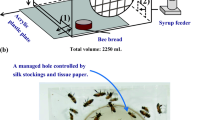Abstract
The consumption of sugar is an important part of the energy intake of social insect. Its monitoring provides information regarding the costs and efficiency of energy flow in a colony. This study aims at tracking the sugar flow from a sugar source to artificial bumblebee micro-colonies and at quantifying the amount of sugar consumed by the larvae. We developed a new method of sugar tracking that utilises an inert lanthanide complex (GdDOTA) dissolved in an aqueous sugar solution. The delayed defecation of bee larvae enabled the collection of all faeces from a cocoon. The amount of digested sugar corresponded to the amount of the lanthanide in the faeces, which was quantified using inductively coupled plasma spectrometric techniques. We highlight the possibility of the novel developed method to be extended for tracking the energy flow within a colony using up to 15 different metal markers without the necessity of killing individuals.


Similar content being viewed by others
References
Aime, S., Botta, M., Fasano, M., Marques, M.P.M., Geraldes, C.F.G.C., Pubanz, D., Merbach, A.E. (1997) Conformational and coordination equilibria on DOTA complexes of lanthanide metal ions in aqueous solution studied by 1H-NMR spectroscopy. Inorg. Chem. 36(10), 2059–2068
Alford, D.V. (1975) Bumblebees. Davis-Poynter, London
Allison, J.D., Baugh, T.D. (1994) Use of complexed lanthanide and Group 3A metal anions as chemical tracers. Res. Discl. 366, 553
Bousquet, J.C., Saini, S., Stark, D.D., Hahn, P.F., Nigam, M., Wittenberg, J., Ferrucci Jr., J.T. (1988) Gd-DOTA: characterization of a new paramagnetic complex. Radiol. 166(3), 693–698
Cnaani, J., Schmid-Hempel, R., Schmidt, J.O. (2002) Colony development, larval development and worker reproduction in Bombus impatiens Cresson. Insectes Soc. 49(2), 164–170
DeGrandi-Hoffman, G., Hagler, J. (2000) The flow of incoming nectar through a honey bee (Apis mellifera L.) colony as revealed by a protein marker. Insectes Soc 47(4), 302–306
Giesen, C., Mairinger, T., Khoury, L., Waentig, L., Jakubowski, N., Panne, U. (2011) Multiplexed immunohistochemical detection of tumor markers in breast cancer tissue using laser ablation inductively coupled plasma mass spectrometry. Anal. Chem. 83(21), 8177–8183
Goulson, D. (2003) Bumblebees: Their Behaviour and Ecology. Oxford University Press Inc., New York
Hagler, J.R., Jackson, C.G. (2001) Methods for marking insects: current techniques and future prospects. Annu. Rev. Entomol. 46(1), 511–543
Heinrich, B. (2004) Bumblebee Economics. Harvard University Press, Cambridge
Kearns, C.A., Thomson, J.D. (2001) The Natural History of Bumblebees: A Sourcebook for Investigations. University Press of Colorado, Boulder
Merbach, A.E., Tóth, É. (2001) The Chemistry of Contrast Agents in Medical Magnetic Resonance Imaging. Wiley, Chichester
Michener, C.D. (1974) The Social Behavior of the Bees: A Comparative Study. Harvard University Press, Cambridge
Michener, C.D. (2007) The Bees of the World, 2nd edn. The Johns Hopkins University Press, Baltimore and London
Nienhaus, G.U. (2008) The green fluorescent protein: a key tool to study chemical processes in living cells. Angew. Chem. Int. Ed. 47, 8992–8994
Nixon, H.L., Ribbands, C.R. (1952) Food transmission within the honeybee community. Proc. R. Soc. Lond. B 140(898), 43–50
Pendrel, B.A., Plowright, R.C. (1981) Larval feeding by adult bumble bee workers (Hymenoptera: Apidae). Behav. Ecol. Sociobiol. 8(2), 71–76
Pereboom, J.J.M. (2000) The composition of larval food and the significance of exocrine secretions in the bumblebee Bombus terrestris. Insectes Soc. 47(1), 11–20
Quezada-Euán, J., López-Velasco, A., Pérez-Balam, J., Moo-Valle, H., Velazquez-Madrazo, A., Paxton, R. (2011) Body size differs in workers produced across time and is associated with variation in the quantity and composition of larval food in Nannotrigona perilampoides (Hymenoptera, Meliponini). Insectes Soc. 58(1), 31–38
Regali, A., Rasmont, P. (1995) Nouvelles méthodes de test pour l’évaluation du régime alimentaire chez des colonies orphelines de Bombus terrestris (L) (Hymenoptera, Apidae). Apidologie 26(4), 273–281
Rieckermann, J., Bares, V., Kracht, O., Braun, D., Gujer, W. (2007) Estimating sewer leakage from continuous tracer experiments. Water Res. 41(9), 1960–1972
Roulston, T.H., Cane, J.H. (2002) The effect of pollen protein concentration on body size in the sweat bee Lasioglossum zephyrum (Hymenoptera: Apiformes). Evol. Ecol. 16(1), 49–65
Roulston, T.H., Cane, J.H., Buchmann, S.L. (2000) What governs protein content of pollen: pollinator preferences, pollen–pistil interactions, or phylogeny? Ecol. Monogr. 70(4), 617–643
Řehoř, I., Kubíček, V., Kotek, J., Hermann, P., Száková, J., Lukeš, I. (2011) Modification of nanocrystalline TiO2 with phosphonate- and bis(phosphonate)-bearing macrocyclic complexes: sorption and stability studies. Eur. J. Inorg. Chem. 2011(12), 1981–1989
StatSoft Inc. (2011) STATISTICA (data analysis software system). www.statsoft.com
Tautz, J. (2009) The Buzz about Bees: Biology of a Superorganism. Springer, Berlin
Tholey, A., Schaumlöffel, D. (2010) Metal labeling for quantitative protein and proteome analysis using inductively-coupled plasma mass spectrometry. Trends Anal. Chem. 29(5), 399–408
Acknowledgments
We thank Jiřina Száková (University of Life Sciences, Prague) and Jan Rohovec (Academy of Sciences of the Czech Republic) for preliminary measurements of the data and Jan Votava for help with statistical analysis. This project was supported by the Czech Science Foundation, project no. P506/10/0403 and project no. TA01020969 of the Technology Agency of the Czech Republic. Support to K.Č. was given by the SVV project (Integrative Animal Biology) no. SVV-2013-267 201.
Author information
Authors and Affiliations
Corresponding author
Additional information
Manuscript editor: David Tarpy
Mesurer la consommation en sucre des larves dans des micro-colonies de bourdon: une nouvelle méthode prometteuse pour suivre les flux de nourriture chez l’abeille
Technique de marquage / lanthanide / glucides / insecte / ICP-OES
Messung des Zuckerverbrauchs von Larven in Hummel-Minivölkern: Eine vielversprechende neue Methode um die Ernährungsökonomie bei Bienen zu verfolgen
Markierungstechnik / Lanthanide / Kohlenhydrate / Insekten / ICP-OES
Rights and permissions
About this article
Cite this article
Řehoř, I., Macháčková, L., Bučánková, A. et al. Measuring the sugar consumption of larvae in bumblebee micro-colonies: a promising new method for tracking food economics in bees. Apidologie 45, 116–128 (2014). https://doi.org/10.1007/s13592-013-0233-6
Received:
Revised:
Accepted:
Published:
Issue Date:
DOI: https://doi.org/10.1007/s13592-013-0233-6




